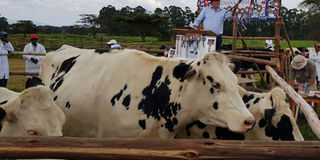What it’d take to survive the future in dairy farming

Dairy cows at a past auction in Nakuru. The success of the dairy industry in future will greatly depend on positive interventions by the various involved stakeholders. FILE PHOTO | NMG
What you need to know:
- Proper storage and efficient utilisation of the available resources, farm mechanisation, a shift from the current small herd sizes of one to two dairy cows by majority of smallholder producers to more than five animals is not optional if production cost is to be reduced.
- County governments in dairy and agricultural potential areas in collaboration with farmers’ barazas need to set up programmes that boost dairy production.
- It is worth noting that processing milk within the production point (cooperative or county level) will greatly reduce losses incurred between the farmer and the processor.
- The minimum acreage for agricultural land need to be stated and enforced to reduce over subdivision and ensure the said land can support agriculture efficiently.
Despite the great contribution of the dairy sector to the national economy, the country has witnessed continuous collapse or shift of operation by many large, medium and smallholder farmers over the recent years.
This is attributed to land ownership challenges, low return on investment due to increased cost of production, unwillingness for the young generation to take over from their predecessors and better investment options.
The industry also faces a wide range of challenges ranging from unpredicted drought, high input costs, lack of capital, poor quality animals, competition for land use with alternatives, lack of sufficient government subsidies, uncontrolled dairy and dairy products importation, high mortalities and veterinary diseases, lack of sufficient extension services, huge post-harvest losses and low market price for produce.
Therefore, the success of the dairy industry in future will greatly depend on positive interventions by the farmer and various stakeholders, including government.
As the number of large-scale farms and production resources continue to diminish, there is need to increase intensification and commercialisation of smallholder dairies as the only option to sustain production.
Cooperative societies
Use of high quality genetics with great feed conversion efficiency and high milk production potential is inevitable.
Proper storage and efficient utilisation of the available resources, farm mechanisation, a shift from the current small herd sizes of one to two dairy cows by majority of smallholder producers to more than five animals is not optional if production cost is to be reduced.
Joining or formation of cooperative societies with the objective of marketing processed milk and milk products at the county level will be an added advantage.
The societies should also offer addition services such as coordinate training, milk cooling, artificial insemination, feed and agrovet services to its members.
Where possible, a number of like-minded farmers can form a dairy management group that can employ the services of a qualified livestock manager to manage the herds and advise the farmers while contracting veterinary services from qualified veterinarians.
County governments in dairy and agricultural potential areas in collaboration with farmers’ barazas need to set up programmes that boost dairy production.
The county governments need to facilitate the formation of cooperative societies, train dairy producers, coordinate and provide breeding services, provide soft loans to farmers and farmer groups to buy necessary equipment and breeding stock.
Initiatives such as the “one cow per family”, provision of cooling plants, subsidised AI services, loans to purchase breeding stock, feeds and feed processors in some counties are exemplary interventions that need adoption.
Value addition
County governments’ contribution to dairy development should extend to product marketing by assisting the potential groups to package and market their produce.
It is worth noting that processing milk within the production point (cooperative or county level) will greatly reduce losses incurred between the farmer and the processor.
This can also assist positively in traceability and branding of the milk by a processor in the market.
The national government, on the other hand, should develop policies that will protect and facilitate growth of the dairy industry.
Training curriculums in schools, tertiary agricultural institutions and universities should promote agriculture.
Agriculture could possibly be made a mandatory subject in both primary and secondary education.
The number of tertiary institutions offering both short-training and diploma agricultural training should be increased since some colleges have been converted to universities.
Prime agricultural land need to be protected against excessive subdivision and change of land use as seen in some counties.
The minimum acreage for agricultural land need to be stated and enforced to reduce over subdivision and ensure the said land can support agriculture efficiently.
The role played by development partners can never be under-estimated. They need to be supported by both farmers and the governments to achieve their intended objectives.
The country’s dairy regulator, the Kenya Dairy Board, needs to discharge its role efficiently and at the same time set aside portion of the revenue collected to develop the dairy infrastructure.
Musyoka Duncan is based at Egerton University.




